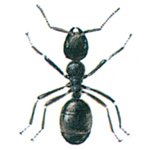
Ants have a special position among insects. They are so many of them and they live in communities that are easily comparable with our own.
About ten thousand different species of ants are known today, and the ants have over time adapted to almost every conceivable habitat, just except the completely naked Arctic. Ants have been found in amber. Ants that have been caught in the resin almost 50 million years ago. Ants have also been found in amber dating to a time almost 100 million years back.
The black garden ant (Lasius niger) can be found all over Europe, and as it is extremely common on streets, in yards, gardens and houses it is often this ant we encounter.
Worker ants are 3 mm long and are actually more brown than black. Their societies usually consist of 5 to 10,000 members, and there is usually only one egg-laying queen in every community.
The ant colony is most often built in the ground, under stones or tiles that receive a fair amount of sunlight. Inside houses ants will usually settle in a cavity wall or under the floors.
The common black ants are species which are highly dependent on aphids whose sugary excrement constitute an important part of their diet. They can take care of and protect aphid colonies against larvae of hover flies, ladybugs and other of the aphids’ enemies. In some cases, they may even build “stables”, small chambers for the protection of a colony of aphids which feed on roots. They complement the sweet diet with various small insects that they overwhelm and drag home to the colony. They have a large working radius, and if an ant finds something edible it can inform the other ants. It lays out a scent, and pats the other ants with its antennae, and even gives them a taste that it regurgitated.
It is especially in the early spring you can experience the caravans of ants looking for the sweets in the kitchen, later on the summer they prefer to forage outdoors.
The first signs of ants in the house are often small piles of sand and gravel that pop up at the panels. The ants dumps this sand and gravel, and the piles also contain the remains of dead insects such as ants, and empty pupae.
A more dramatic indication that there are ants in the house can be that suddenly in the summer thousands of winged ants occur in a room.
In a functioning ant community a large number of winged males and females (flying ants) are produced during the summer. The males are small and wasp-like, the females – the queens to be- are up to 1 cm long. The winged ants seek towards light, they must be out in the wild to mate so you will find them on window sills and crawling in the curtains.
This swarming takes place simultaneously from many communities in the area. The winged ants mingle with garden ants from other communities and mate. The synchronisation is achieved partly by means of an “internal biological clock” but is also dependent on the weather. Warm, quiet days provide the right conditions, and when there are many flying ants in the air, you will often also see crowds of circling gulls that like to eat the fat female ants.
The males die soon, they fertilised queens shed their wings and must now try to establish a new community.
There is seldom any reason to fight the black garden ants outdoors. Ant colonies right at the socket of the house may pose a risk of ant seeking indoor and here it may be reasonable to control with a watering remedy for ants, possibly. an insect powder.
Inside the house, the black garden ants are usually harmless, but they can of course be very annoying. If ants have settled under the house, it is difficult to completely exterminate the colony. A treatment where they come out at panels or piping with an approved insecticide dust or spray can have an effect, and the different types of ant-lure boxes also have effects against ants.
There is a tendency that these communities that live under houses will move out to the socket when the sun shines more, and here is the opportunity to hit them with the above mentioned means.




